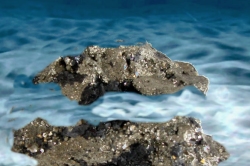|
Many important metal ores are sulphides. Those include galena (lead sulphide), pyrite (iron di-sulphide), argentite (silver sulphide), chalcopyrite (iron-copper sulphide) and many more. Copper or Zinc sulphide deposits are common in the Earth’s crust, and particularly large deposits are present in the Canadian Shield (the vast geological area that forms the nucleus of the North American craton. The shield stretches north from the Great Lakes to the Arctic Ocean, covering over half of Canada and extending south into the northern parts of the United States.). This has made Canada an excellent site for the study of sulphides.
|
A sulphide is an anion of sulphur and in fact constitutes the lowest oxidation state of sulphur. In the presence of oxygen, sulphides become oxidized to sulphates. This is what happens in oceans where the process comes from the "rusting" of rocks by atmospheric oxygen. This creates sulphate through chemical reactions with pyrite, the iron sulphide material known as 'fool's gold'. Sulphate (SO2-4) is the second most common anion in the oceans today. The concentration of sulphate in the oceans is approximately 28,000 µmol/l. But the latest research just published in Nature Geoscience shows that this was not always the case. Indeed, the ancient oceans of some 2,7 billion years ago had sulphate concentrations as low as 80 µmol/l.
|
|
|
Researchers from McGill University in Canada compared the concentrations of sulphates in copper and zinc sulphide ore from ancient oceans with modern hydrothermal settings. The samples for the ancient ore came from a copper-zinc mine in northern Ontario (the Kidd Creek copper-zinc mine in Timmins, Ontario) that was once a volcanically active ancient seafloor.
The researchers measured the 'weight' of sulphur in samples of sulphide ore using a highly sensitive mass spectrometer. This weight is determined by the different amounts of isotopes of sulphur in a sample. Meanwhile the abundance of different isotopes indicated how much seawater sulphate was incorporated into the mass of sulphide ore that formed at the bottom of ancient oceans. With time and tectonic movement this ancient ore is now found above sea level - for example in the Canadian Shield.
The data obtained from this research show that the level of sulphate in ancient oceans was approximately 350 times lower that of today. This is an extremely low level from which we can further extrapolate to conclude that the level of available oxygen was probably also very low at that time.
However, it is known that despite the low levels of sulphate and oxygen, the ancient ocean still supported an active global population of microbes that used sulphate to gain energy from organic carbon. This research shows that we have the tools (and very precise ones) to probe the development of very early life on earth, and to discover new ways of understanding how life evolved.
Journal Reference:
- J. W. Jamieson, B. A. Wing, J. Farquhar, M. D. Hannington. Neoarchaean seawater sulphate concentrations from sulphur isotopes in massive sulphide ore. Nature Geoscience, 2012; (Published online on the 2nd of December 2012)
|
© Biscuit Software 2004-2015
All rights reserved
|

